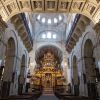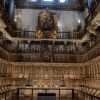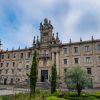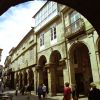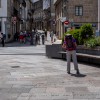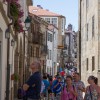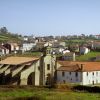- Accede I
- Regístrate I
- carrito
20. Iglesia de San Martín Pinario
20. Iglesia de San Martín Pinario
Galería de imágenes

A raíz del descubrimiento de los restos del Apóstol fueron muchas las órdenes que se establecieron en Santiago y que hoy perduran.
Los benedictinos de San Martín Pinario fueron haciéndose poco a poco muy poderosos, consiguiendo hacer sombra al propio cabildo catedralicio. Era tal su rivalidad, que los canónigos prohibieron a los benedictinos elevar las torres de la iglesia de San Martín más allá de la altura de la fachada, para que no compitieran con las de la catedral. A pesar de ello, hoy puede afirmarse que el monasterio de esta orden es el segundo monumento más importante de Santiago tras la catedral.
Su iglesia fue construida a finales del siglo XVI. La fachada, trazada en 1597, está concebida como un altar pétreo. Lo presiden la Virgen, San Benito y San Bernardo, mientras que en el frontón superior está San Martín partiendo su capa con un pobre. Sin embargo, la imagen más llamativa del edificio es su escalinata curva y descendente del siglo XVIII, diseñada por el dominico Fray Manuel de los Mártires, siguiendo un claro trazado barroco, similar al de otros modelos italianos.
El interior posee planta de cruz latina con tres naves en el brazo principal y una en el transversal, recorridas por una balconada. Llama poderosamente la atención el fastuoso retablo mayor diseñado por Fernando de Casas y Novoa, y ejecutado por Romay, que se considera el mejor retablo barroco de Galicia y probablemente de España. Es preciso destacar la sillería del coro, situada detrás del altar mayor, que fue realizada en nogal por Mateo de Prado, y que es reconocida como la más importante de las existentes en Galicia.
Más recientemente, otra sillería coral ha venido a añadirse a la riqueza de la iglesia de San Martín. Se trata del antiguo coro lígneo de la Catedral, del siglo XVII, que fue desmontado en 1945 y trasladado al monasterio gallego de Sobrado dos Monxes. En el año 2004, después de una compleja y laboriosa restauración, regresa a Santiago para mostrar todo su esplendor renacentista labrado en madera de nogal.











